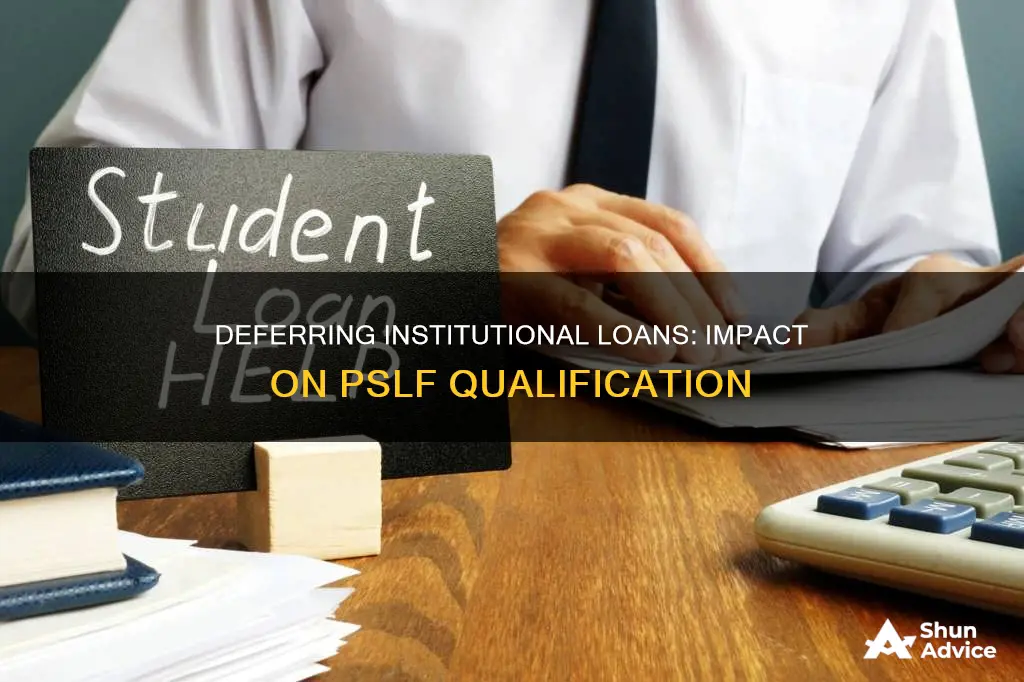
The Public Service Loan Forgiveness (PSLF) program is a federal initiative that offers tax-free loan forgiveness to borrowers after 120 monthly payments. This equates to 10 years' worth of payments while working full-time for a qualifying employer, typically in government or non-profit jobs. While PSLF has strict requirements, recent student debt relief efforts have relaxed some rules, allowing certain periods of deferment and forbearance to count toward PSLF. However, it is important to note that private loans, state loans, institutional loans, and other financing tools are generally ineligible for PSLF. This article will explore whether deferring institutional loans disqualifies borrowers from PSLF and provide insights into the program's requirements and recent changes.
| Characteristics | Values |
|---|---|
| Does deferring institutional loans disqualify from PSLF? | No, but it does not count toward PSLF unless it's a military deferment or forbearance. |
| Who is eligible for PSLF? | Borrowers with federal student loans who work in qualifying nonprofit or government jobs. |
| How many payments are required for PSLF? | 120 monthly payments. |
| What is the timeline for PSLF? | 10 years of payments. |
| Are there any special considerations? | Borrowers with Federal Family Education (FFEL) Program loans, Perkins loans, or other federal student loans must consolidate their loans into a Direct Consolidation Loan to qualify. |
| Are there any loan types that are not eligible for PSLF? | Private loans, state loans, institutional loans, defaulted Direct Loans, and other higher education financing tools are not eligible. |
What You'll Learn
- Deferment and forbearance periods before 2013 may count toward PSLF
- Military service deferment after 2013 counts toward PSLF
- In-school deferment periods do not qualify for PSLF
- COVID-19 payment waivers counted for PSLF if the borrower was in eligible employment
- PSLF is only available for federal student loans

Deferment and forbearance periods before 2013 may count toward PSLF
Deferment and forbearance periods before 2013 may count toward Public Service Loan Forgiveness (PSLF). However, it is important to note that this is not always the case, and there are specific criteria that must be met for these periods to qualify. Firstly, any months spent in deferment or forbearance must be on an eligible repayment plan, such as an income-driven repayment (IDR) plan, and borrowers must have been working for a PSLF-qualifying employer during these periods. This includes working in a qualifying nonprofit or government job.
It is also crucial to understand that not all types of deferment or forbearance are eligible. For instance, in-school deferment, grace periods, and delinquent or defaulted loans are generally excluded from PSLF. Additionally, the borrower's actual loan rate and financial history can impact whether deferment and forbearance periods before 2013 count toward PSLF. Lower rates may be available to borrowers with creditworthy cosigners, graduate degrees, and shorter repayment terms.
To receive credit for eligible forbearance periods, borrowers must use the PSLF Help Tool to certify their employment. If borrowers were not working for a qualifying employer during eligible forbearance periods, they may still receive forgiveness credit, but it would be strictly toward IDR forgiveness, which operates on a 20- to 25-year timeline. It is worth noting that the COVID-19 pandemic payment pause counts toward overall forgiveness payment counts but not toward the forbearance totals.
While deferment and forbearance periods before 2013 may count toward PSLF under certain conditions, it is always advisable to consult official sources and seek professional advice to understand the most up-to-date and accurate information regarding loan forgiveness programs and their requirements.
Construction Loans: Appliances Included or Not?
You may want to see also

Military service deferment after 2013 counts toward PSLF
The Public Service Loan Forgiveness (PSLF) program is a federal initiative that erases a borrower's federal student loan balance after 10 years' worth of monthly payments (120 payments in total) while working for the government, non-profit organisations, or certain other qualifying employers. The program is designed to encourage students to enter potentially low-paying but socially valuable careers, such as firefighting, teaching, government, nursing, law, the military, and religious work.
Previously, members of the military who had their loans deferred or in forbearance while on active duty often found that this time did not count toward PSLF. This created a significant barrier for service members seeking loan forgiveness. However, recent changes to the PSLF program have addressed this issue.
The Department of Education has announced that it will now allow months spent on active duty to count toward PSLF, even if the service member's loans were in a period of deferment or forbearance. This means that if a service member's loan payments were paused due to their military service, that entire period will be credited toward PSLF forgiveness. This change ensures that members of the military can focus on their service without worrying about their student loan payments or the impact on their PSLF progress.
In addition to this direct benefit for service members, the Department is also taking other steps to improve the PSLF process for them. Beginning in 2024, the Department will implement a data-matching process to automatically credit service members and veterans for their time in uniform. This will be done by matching Department of Education data with information from other federal agencies about service members and the federal workforce. This automated process will make it easier for service members to receive the PSLF credit they are entitled to without having to navigate complex eligibility requirements.
Cosigning Loans: Citizen Requirements and Financial Implications
You may want to see also

In-school deferment periods do not qualify for PSLF
Forbearance periods provided by the COVID-19 Emergency Relief Flexibilities, for example, are not included in the qualifying forbearance months. On the other hand, any months spent in any type of deferment before 2013 (excluding in-school deferment) can be counted toward PSLF. The key to receiving credit for forbearance that counts toward PSLF is to confirm that you were working for a PSLF-qualifying employer during eligible forbearance periods.
To do this, borrowers can use the PSLF Help Tool to certify their employment for these periods. If borrowers were not working at a public or nonprofit employer during eligible forbearance periods, they could still receive forgiveness credit, but it would only apply to IDR forgiveness, which follows a 20- or 25-year timeline. Additionally, borrowers with periods of active-duty military service can count those months toward PSLF, even if they were in military deferment or forbearance.
It's worth noting that the rules and requirements surrounding PSLF may change over time, and temporary adjustments or waivers may be offered, as seen with the IDR Account Adjustment, which expired on June 30, 2024. This adjustment allowed borrowers to qualify for additional loan forgiveness credit if they had months spent in economic hardship deferment or military service deferment after 2013. Therefore, it is always a good idea to stay informed about the latest updates and seek official sources for the most accurate and up-to-date information.
Davis Law Group: Title Loan Services and More
You may want to see also

COVID-19 payment waivers counted for PSLF if the borrower was in eligible employment
Deferring institutional loans can affect your eligibility for the Public Service Loan Forgiveness (PSLF) program. Generally, payments made while the loan is in deferment do not count towards PSLF. However, there may be exceptions during specific periods, such as the COVID-19 pandemic.
During the COVID-19 pandemic, payment waivers were applied to all federally held federal loans, including Direct Loans. This meant that no payments were due on any of these loans. Importantly, this period does count for PSLF purposes if the borrower was in eligible employment during this time. Borrowers will need to submit proof of their eligible employment during the COVID-19 waiver period to ensure that this time is counted towards PSLF. It is worth noting that there is no benefit to making payments during the COVID-19 waiver period if you are pursuing PSLF, as the waiver covers this period.
The COVID-19 pandemic has placed a significant strain on public servants, and the PSLF program aims to alleviate some of the financial burdens associated with student debt. The Department of Education has implemented a Limited PSLF Waiver to address this issue. This waiver allows all prior payments made by student borrowers to count towards PSLF, regardless of the loan program. Any prior payments made while working for a qualifying employer will be considered a qualifying payment, regardless of the loan type or repayment plan. This includes borrowers who have already consolidated their loans into the Direct Loan Program and certified some employment for PSLF.
Additionally, the Department of Education has clarified that periods of eligible employment used for Teacher Loan Forgiveness will be counted under the PSLF waivers. This is particularly important for borrowers with loans from the Federal Family Education Loan (FFEL) Program, as many of them have reported receiving inaccurate information from their servicers about how to make progress toward PSLF. By counting payments made on FFEL loans toward PSLF, the Department of Education aims to correct these issues and help address the impact of the COVID-19 pandemic on student loan borrowers.
Deardens and Loans: What's the Connection?
You may want to see also

PSLF is only available for federal student loans
Public Service Loan Forgiveness (PSLF) is a federal program that forgives your federal student loan debt after 10 years of payments (120 monthly payments) while working for the government or a nonprofit organization. This program is designed to encourage students to enter potentially low-paying but socially valuable careers, such as teaching, government, nursing, public interest law, firefighting, the military, and religious work.
It is important to note that deferring loan payments while working towards PSLF may impact your eligibility. Payments made while in deferment or forbearance generally do not count towards PSLF, with the exception of active-duty military service members, who will receive credit for deferments or forbearances granted during their service.
To stay on track for PSLF, borrowers should submit a PSLF certification form annually and enroll in an income-driven repayment (IDR) plan, which caps monthly bills at a set percentage of their income. The Education Department's PSLF Help Tool can assist borrowers in determining their eligibility based on their loan types and employment.
Cosigners and Conventional Loans: What You Need to Know
You may want to see also
Frequently asked questions
Private loans, state loans, institutional loans, and other higher education financing tools are never eligible for PSLF. Therefore, deferring institutional loans does not disqualify you from PSLF since you were never eligible in the first place.
Federal student loans are eligible for PSLF. This includes Direct Loans, Federal Family Education (FFEL) Program loans, and Perkins loans.
To qualify for PSLF, you must make 120 monthly payments on time and in full while working full-time for a qualifying employer (government or nonprofit) and on a qualifying repayment plan.







